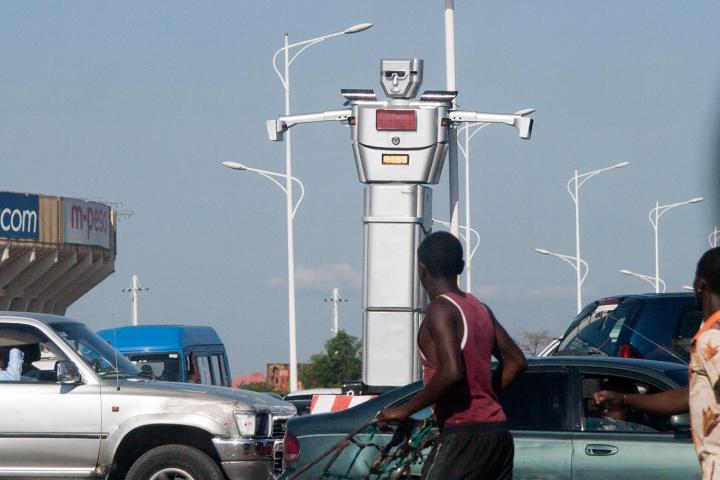
Humanoid robots permeate the annals of science fiction, but outside of a few friendly types such as Robbie from Lost in Space, Johnny 5 and Jude Law’s happy Gigolo Joe in A.I., most don’t take kindly to humans. Think of Gort in The Day The Earth Stood Still, the Terminator killbots, the fugitive Nexus 6 replicants in Blade Runner, the brutal robot cops in Elysium, the list goes on forever.
So it perhaps comes as no surprise that when puny humans are given robotic overlords – or at least robotic Bill Lumbergh-esque managers – we tend to follow orders. Take, for example, one recent situation in the war-torn Democratic Republic of Congo in Africa. The area is not generally known as a hotbed of robotics research, but an experiment there underscores our apparent knack for robot subservience.
Traffic in the capital of Kinshasa could best be described as “chaotic” until engineer Isaie Therese cobbled together a pair of 8-foot-tall robots to direct traffic at a couple of intersections. They look closer to the realm of 50s sci-fi than the fluid, humanoid robots now seen in movies and top research projects; they’re just big, clumsy, silver-painted tin cans with arms that move, built-in LED traffic lights and cameras, all powered by solar cells.
Thing is, traffic conditions at the robot-controlled intersections suddenly improved. A lot. In a Washington Post story about the effect the robots are having on drivers, commuter Demouto Mutombo told CCTV Africa through an interpreter: “As a motorcyclist I’m very happy with the robot’s work. Because when the traffic police control the cars here there’s still a lot of traffic. But since the robot arrived, we see truly that the commuters are respectful.” Interesting.
Why do immobile, nonthreatening robots inspire more trepidation in drivers than human (and possibly armed) traffic cops? Engineer Therese told the Post she thinks drivers obey the robots because unlike humans, they can’t be reasoned with, bribed or distracted. Run the light and you might get a ticket. Or arrested. It’s all on video. The Kinshasa incident also raises the question as to what lengths humans will take orders from a robot. A recent experiment in Canada may have shed light on that answer.
The University of Manitoba’s Department of Computer Science gathered together a group of human guinea pigs a task of increasing drudgery: changing photo files from JPEGs to PNGs on a computer. They were supervised by either a lab-coated human, or a cute, diminutive, child-like Aldeberan NAO (“Now”) humanoid robot, a highly advanced machine often used in therapy with autistic children and robot-human interaction research. NAO packs some impressive dance moves as well, but intimidating, they aren’t. Or are they?
First, subjects had to rename 10 files, and once that set was complete, they were given more sets with more files – many more, up to 5,000 more – to change until they revolted and eventually refused. The test subjects had to work through four levels of complaining and being told to get back to the grindstone before they were fired, per se, from the experiment. So how long did it take for the humans to rise up and tell off their silicon-based superiors? A long time. Some, even when threatening to quit, dutifully returned to work when the little NAO bot prodded them on.
But researchers also said that human coercion was more effective in this case than the requests to continue from the child-like NAO bots. I wonder what the results would have been like if the robots had been sourced from the set of the Battlestar Galactica reboot.
If you’re thinking this experiment sounds familiar, you’re absolutely right. In the infamous Milgram experiment, subjects were ordered by superiors (the researchers) to conduct what they thought was actual physical torture on other subjects until they refused to continue. They rarely did, with a majority administering what they believed to be a fatal electric shock when ordered. Seems we are very, very programmed to do as we are told.
Today, we are surrounded by robots that subtly (or not so subtly) give us orders, robots that we have have woven into the social fabric of modern society. When you call the bank and navigate phone jail, listen to the automated commands on your commuter train or talk to that hospital telepresence bot, the line between the cellular-based and chip-controlled authority figure seems to fade. With children, it often disappears entirely.
Are we destined to become obedient minions to super-smart and super-deadly toasters, or will there be a Galactica-level backlash that takes us back to technology-free existence of hunters and gatherers? Seeing as how most humans seek out leisure rather than conflict, it will be very hard to put the robo toothpaste back in the tube as the technology rapidly moves forward. Mix in sentient artificial intelligence and it’s possible we could lose our grip on the reins of robotics entirely. What then? Will we obey our robot overlords if they ultimately give us security and prosperity?
Leave your thoughts on this subject in comments.
Editors' Recommendations
- The future of automation: Robots are coming, but they won’t take your job
- A disembodied robot mouth and 14 other 2020 stories we laughed at
- This robot will change your tires in a fraction of the time a mechanic can
- Robot bartending company is handing out cash to the people it is replacing
- We’re slowly trapping ourselves under an umbrella of space junk


